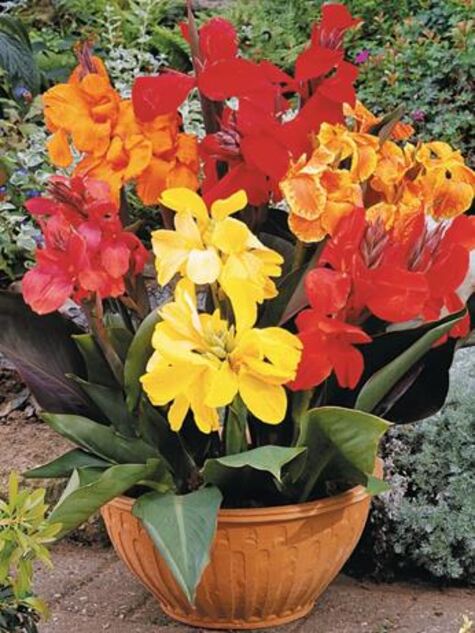
Dwarf Cannas from Burpee.com
“Life is itself a school, and Nature always a fresh study.” ~ Hugh Miller, 1802-1856, Scottish geologist, paleontologist, and folklorist
Bigger is not necessarily better in the horticulture community. New and exciting dwarf plants produce flowers, vegetables, fruit, and colorful foliage that is ideal for small gardening spaces, in containers, or on a balcony, patio, or windowsill. These wonderous plants are constantly being bred and hybridized for the consumer market, under such names as Mini, Miniature, and Dwarf. Look for them in garden centers and in seed and plant catalogues.
- The bright colors of Canna blossoms will add a lush, tropical feel to any space. This dwarf variety was bred to fit containers on a balcony or patio, growing from 24-inches to 3 feet in height, with a 14-inch spread. They need full or part sun, and moist soil. Feed them lightly after new growth with a slow-release fertilizer. Remove spent flower heads to keep plants flowering until fall. They are available in larger plant outlets or online for next season’s shipping.
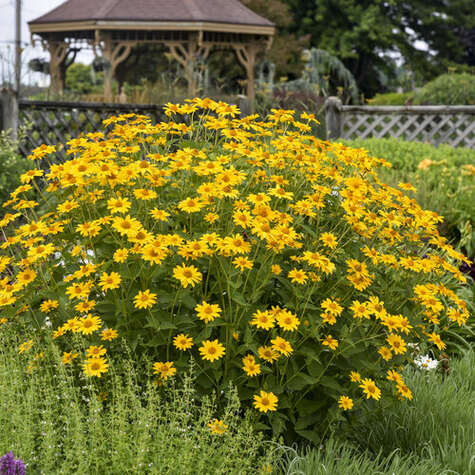
Tuscan Sun Heliopsis from ProvenWinners.com
- For those who would like to grow sunflowers, but don’t have the space, this compact version, Heliopsis Sunflower, is a plant to fulfill that need. “Tuscan Sun” from Proven Winners offers a spot of vibrance in a small space. Its golden yellow flowers with brown seed heads bloom atop sturdy stems from mid to late summer; staking is not needed. These sturdy 3-foot-high plants are heat- and drought-tolerant, and spread to 2-feet in width. Plant them in full of part sun; deadheading is not necessary for long bloom season. They perform exceptionally well in containers.
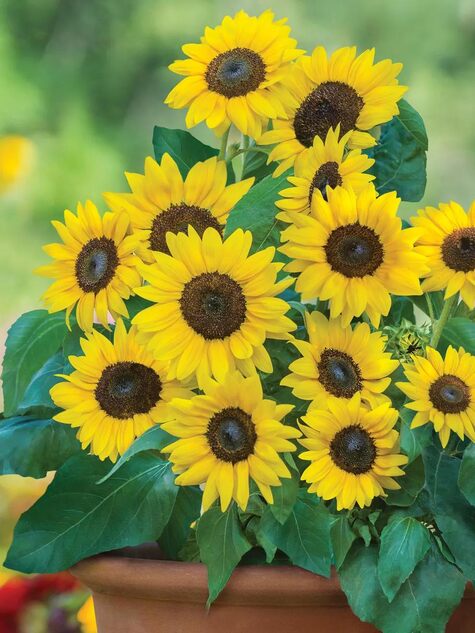
Sunflower, Sunray Yellow Dwarf from Burpee.com
- Another option for the fun of sunflowers without the towering height is Sunray Yellow Dwarf sunflower. This unique plant branches out to bear up to fourteen 4″ flowers on each plant. This is a big and bright addition to any garden, big or small, in patio containers or beds and borders. Full sun; 20-22-inches high, 18-20-inches wide.

‘Wild Rose’ Coral Bells (Heuchera) from ProvenWinners.com
- Coral Bells (Heuchera) will add a delightful, cool spot of color to a garden border, as a stand-along accent, or as the star of container combinations. “Wild Rose” has glossy, deep rose-purple foliage with dark veining; colors can become intense with summer’s heat and humidity, and will grow vigorously to 10-inches tall and 20-inches wide. The rosy-purple flowers appear on 22-inch scapes. Heuchera can be had in many colors and shades, but the darker colors fare better in our summers than the lighter colors. Plant in humus-rich, well-drained soil in a somewhat shady area with morning sun. The flowers attract bees, butterflies, and hummingbirds. Zones 4-9.
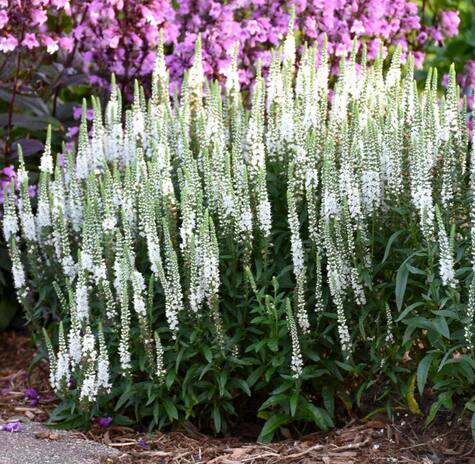
Speedwell ‘White Wands’ from ProvenWinnersDirect.com
- Speedwell “White Wands” from Proven Winners is an excellent plant for forming a backdrop to the darker varieties of This Veronica-hybrid has long-lasting, pure white blooms of 16-plus inches, held up by a short, dense clump of fine textured, forest green foliage. Plant in humus enriched, well-drained soil in full sun. The flowers will cover the top 2/3 of the plant. The flowers are self-cleaning, resulting in a fresher-looking landscape plant. It is deer-resistant, attracts pollinators such as bees and butterflies. Other MagicShow® varieties are ‘Pink Potion’ and the sky blue ‘Ever After.’ Zones 3-8.
- As we head into summer, keep the roots of lawn grasses cool by leaving the grass long. Move the lawn mower setting up to high, and don’t remove more than the top 1/3 of the grass at a time. If rains are scarce, remember to water the lawn deeply, preferably in the evening, giving the grass time to soak in the water before sunrise.
- Drying and preserving cut flowers can add length to their beauty. There are several methods, including air drying by hanging in a cool dark place, drying with sand, the use of silica jells in the microwave, and others. More information at HGTV.com.
- Check the size of plants growing in pots, as it may be time for moving them up in size. Make sure that new containers are clean, or clean used pots with a scrub brush, soap, and water; rinse and dry, then use fresh potting soil with a bit of granular fertilizer.
- Deeply water new transplants when setting them into containers or beds, as they can quickly dry out. Even if it rains, check the soil to 3” deep to make sure their roots have water. Surround with mulch to aid in moisture retention.
- Herbs in the kitchen garden that were planted in March are now in need of care. Harvest basil, cilantro, parsley, and thyme to keep them producing fresh leaves; once many herbs have set seed, the leaves will become bitter.
- Mints (Mentha) love shade. Plant them along the edges of beds, with flowers, and in containers. A favorite place for them to grow is beneath a water faucet or at the end of a gutter downspout! The genus Mentha contains over 25 species which are easily to transplant; keep them contained, however, as they can easily spread into unwanted areas. New varieties have been added to the old-time standards of peppermint and spearmint, including flavors and scents such as apple, pineapple, chocolate, lemon, and from Burpee seeds this year: orange, and mojito.
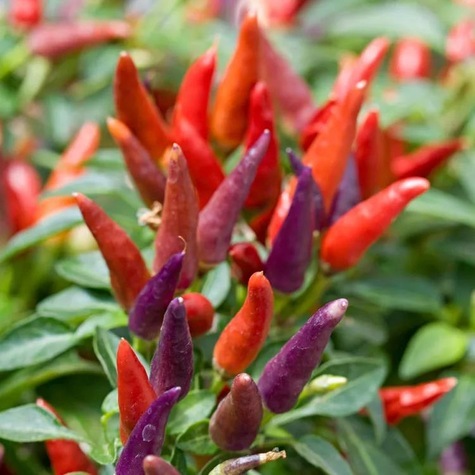
‘Sangria’ Ornamental Peppers from Justin Hancock at BHG.com
- Dwarf vegetable plants are available in many varieties, such as tomatoes, eggplants, and cucumbers. Ornamental peppers have been bred for their looks rather than flavor, even though they are edible. Buy them as transplants, or start them from seed in a sheltered location. The “Sangria” variety sports peppers in red, orange, and purple, with foliage in shades of blue/green and purple/burgundy. This low maintenance annual grows to 6-12-inches tall, and 6-12 inches wide; great for for containers.
- There is still time to plant vegetables through mid-month. Seed Southern peas, summer and winter squashes, pumpkins, and gourds. Be on the lookout for squash borers! More on the vine borers here.
by CMG Adrienne M
Sources: these and other websites: Proven Winners; Burpee Seeds for flowers and mints; Better Homes and Gardens; Central Texas Gardener; A&M AgriLife Research Center; LSU AgCenter.